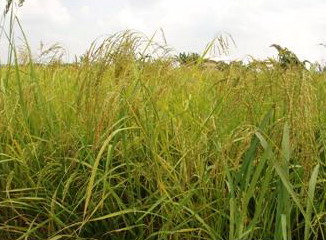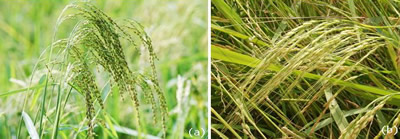Oryza sativa

Latin name
Oryza sativa L.
Family
Poaceae
Common name
Red rice, weedy rice
Synonyms
None
Geographical distribution
Asia: Japan and Korea.
South and Southeast Asia: Bangladesh, India, Indonesia, Malaysia, Pakistan, Philippines, and Vietnam.
Rest of the world: widespread in North and South America.

Morphology
A variable, erect, stout or slender annual rice with varying height and form.
Stem: tufted, erect, hollow and slender or stout, smooth and hairless, 80−120 cm tall.
Leaf: blade flat with parallel veins, 15−30 cm long; ligule and auricle present; ligule usually 10−20 mm long.
Inflorescence: an erect or nodding loose panicle, spikelet about 7 mm long, flat, one-flowered, with or without awns of varying length.
Biology and ecology
Weedy rice is highly variable and thought to originate from outcrosses to wild species (O. nivara, O. rufipogon) or as a result of outcrossing within domestic rice. It is distinguished by the key weedy traits of ready panicle shattering and variable secondary dormancy. It is highly adapted to a wide range of environmental conditions, dry land to deepwater culture. It commonly possesses red pericarp, which requires additional milling, thereby reducing the quality of milled rice.
Agricultural importance
Weedy rice is a major weed in direct-seeded rice. It reduces rice yields and is an alternate host of rice insects, diseases, and nematodes. Often spread by contaminated rice seeds.
Management
Cultural control: the use of crop seed free from wild rice, crop rotation, soil puddling, hand weeding of initial infestations, and water management are possible components of an integrated approach to control weedy rice. Established infestations will need to be addressed through the use of stale seedbeds or water seeding or transplanting.
Chemical control: the application of glyphosate before land preparation or seeding reported to be effective.
Selected references
- Holm L, Doll J, Holm E, Pancho J, Herberger J. 1997. World weeds: natural histories and distribution. John Wiley & Sons, Inc., USA. 1,129 p.
- Holm LG, Plucknett DL, Pancho JV, Herberger JP. 1977. The world's worst weeds: distribution and biology. Honolulu, Hawaii (USA): University of Hawaii Press. 609 p.
- Hsu C. 1978. Gramineae (Poaceae). Flora of Taiwan. 5:373-783.
- Moody K. 1989. Weeds reported in rice in South and Southeast Asia. Manila (Philippines): International Rice Reseach Institute. 442 p.
- Merrill ED. 1976. A flora of Manila. Manila (Philippines): Department of the Interior, Bureau of Science. 491 p.
- Reissig WH, Heinrichs EA, Litsinger JA, Moody K, Fiedler L, Mew TW, Barrion AT. 1986. Illustrated guide to integrated pest management in rice in tropical Asia. Manila (Philippines): International Rice Research Institute. 411 p.
- Vergara BS. 1992. A farmer's primer on growing rice. Manila (Philippines): International Rice Research Institute. 219 p.
- W3TROPICOS at http://mobot.mobot.org/Pick/Search/pick.html.







